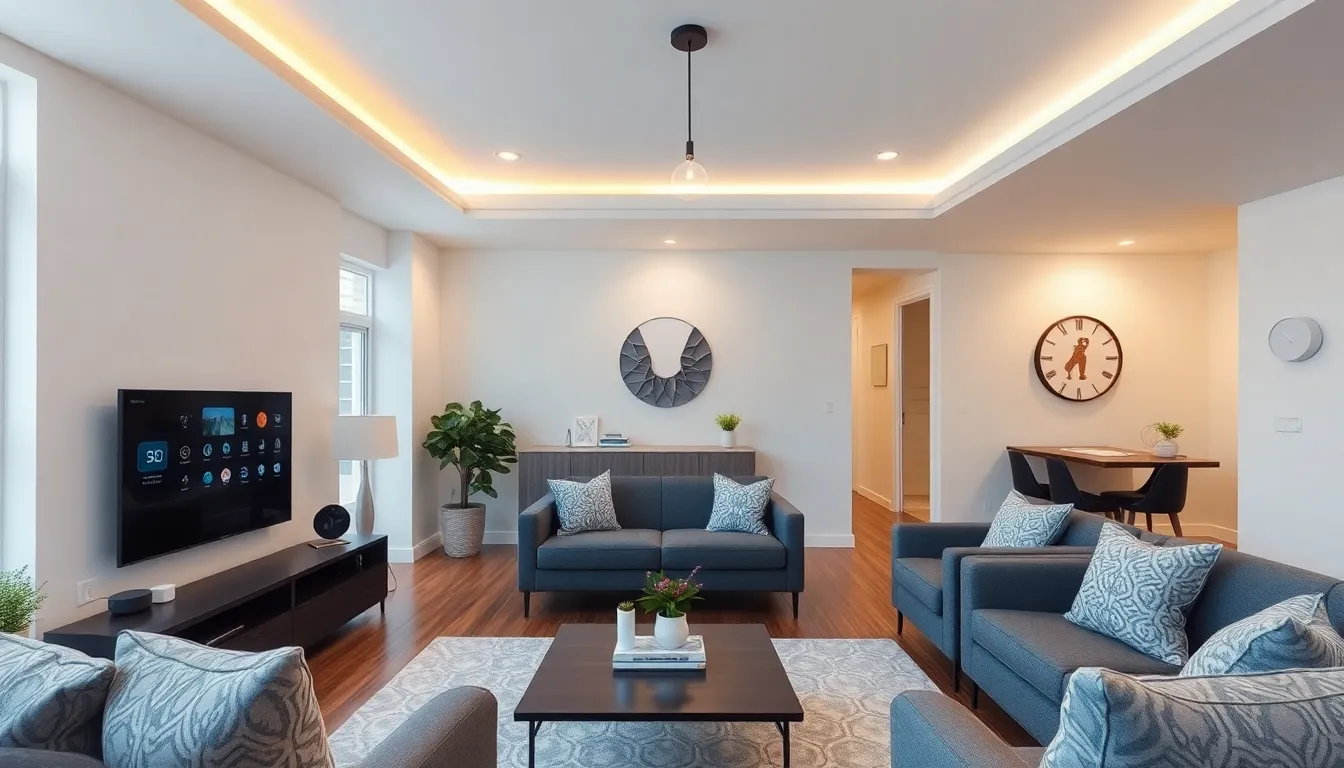Table of Contents
ToggleImagine walking into your home and having the lights turn on, the thermostat adjust, and your favorite playlist start playing—all without lifting a finger. Sounds like magic, right? Well, it’s not just a scene from a sci-fi movie; it’s the reality of home automation systems. These clever setups can transform any ordinary house into a smart haven, making life easier and a lot more fun.
Overview Of Home Automation Systems
Home automation systems streamline daily tasks by connecting devices to a centralized network. These systems allow users to control functions such as lighting, temperature, security, and entertainment through smartphones or voice commands.
Smart thermostats regulate heating and cooling automatically, optimizing energy use and enhancing comfort. Integrated security features include cameras and sensors that monitor activity, offering homeowners peace of mind.
Smart lighting systems adapt to users’ schedules, providing illumination only when needed. Automated music systems allow seamless audio management across different rooms, enhancing the overall ambiance.
Voice assistants play a crucial role in coordinating device interactions, enabling users to execute commands hands-free. Home automation hubs consolidate various devices, ensuring easy integration and management from a single application.
The benefits extend to energy efficiency, cost savings, and increased home value. Systems that provide real-time energy monitoring allow homeowners to track consumption patterns and adjust usage accordingly.
Installation can vary based on system complexity and user preferences. Basic setups may involve installing smart bulbs and plugs, while more advanced systems could require professional installation.
Homeowners should consider compatibility when choosing devices, ensuring they function well within their chosen automation framework. Quality systems not only enhance daily living but also adapt to evolving technology trends, keeping homes connected and efficient.
Benefits Of Home Automation System Installation

Home automation systems offer numerous advantages that significantly enhance modern living. They not only simplify daily tasks but also improve safety and security.
Increased Convenience
Increased convenience marks one of the key advantages of home automation systems. These systems allow users to manage multiple devices from a single smartphone or voice assistant. Smart lighting adjusts automatically based on occupancy, ensuring homes are well-lit only when necessary. Thermostats gain intelligence by learning user preferences, optimizing comfort effortlessly. Users can create schedules for appliances, such as washers or dryers, enhancing efficiency. Integration of home entertainment systems lets families enjoy their favorite shows or playlists with a single command. Control remains straightforward, whether at home or on the go, allowing homeowners to stay connected effortlessly.
Enhanced Security
Enhanced security features significantly benefit from home automation systems. Users can monitor their properties in real time through smart cameras and sensors. Notifications of unusual activities provide homeowners with peace of mind. Automated locks grant access only during designated times, while smart doorbells allow users to see and communicate with visitors remotely. Alarm systems integrate with home automation networks, triggering alerts on smartphones during breaches. Lighting can sync with security systems, illuminating paths when sensors detect motion. Enhanced surveillance capabilities and streamlined control make protecting the home easier than ever before.
Types Of Home Automation Systems
Different types of home automation systems cater to various needs and preferences. Two primary categories are wired and wireless systems.
Wired Systems
Wired systems rely on physical connections to link devices throughout a home. These installations typically include structured wiring, which keeps cables hidden within walls. Having a dedicated broadband connection enhances reliability and speed for data transmission. Electronic components, such as sensors and controllers, often connect through this wiring, providing stable performance. Maintenance can prove more demanding due to the installation complexity and potential need for professional assistance. Installation costs may be higher initially, but scalability and performance often justify the investment for many homeowners.
Wireless Systems
Wireless systems utilize radio signals to connect devices without physical cabling. Bluetooth, Wi-Fi, and Z-Wave technologies commonly enable this type of communication. Flexibility allows users to expand or modify their setups easily, accommodating new devices. Convenience benefits homeowners, as they can install these systems with minimal disruption. Interference may occur in crowded frequency bands, and battery life of devices can affect functionality. Despite these drawbacks, affordability and ease of use make wireless systems popular in modern smart homes.
Steps To Install A Home Automation System
Installing a home automation system involves several important steps that ensure optimal functionality and user satisfaction. Following these structured steps simplifies the process and leads to a successful setup.
Planning Your System
Determining the specific needs is crucial. Identify which devices require automation, such as lights, locks, or cameras. Next, assess compatibility among devices to ensure seamless communication. Evaluate network capabilities, as sufficient Wi-Fi coverage supports effective operation. Prioritizing user preferences allows for a more tailored experience. Overall, thorough planning sets a strong foundation for a successful installation.
Installing The Components
Begin the installation by following the manufacturer instructions for each component. Securely mount devices such as sensors and cameras in strategic locations. Connect smart devices to the central hub using the designated app. Ensure that Wi-Fi signals reach all areas where devices operate. Position the hub in a central location for optimal connectivity. Test each component to confirm proper functionality after installation. Address any connection issues swiftly to maintain a well-rounded experience.
Common Challenges In Installation
Installation of a home automation system often presents various challenges. Compatibility issues frequently arise between different devices or systems, complicating integration. Homeowners might face difficulties when connecting older devices with newer technology, leading to functionality problems.
Complex wiring requirements can pose significant obstacles, especially for those opting for wired systems. Understanding specific protocols and standards becomes essential in such cases. Wireless systems, while offering flexibility, may experience interference from other devices, affecting performance and reliability.
Network limitations also complicate installation. Insufficient bandwidth can result in slow response times or connectivity issues. Homeowners may need to upgrade their internet service or invest in additional hardware to ensure reliable operation.
Physical placement of devices presents another challenge. Proper positioning of sensors and cameras is crucial for effective performance. Incorrect placements can lead to blind spots or inadequate coverage, diminishing the system’s overall efficiency.
User comprehension plays a vital role, too. Many homeowners struggle with the complexity of setup and device management. Clear instructions and user-friendly interfaces are essential to ease the learning curve and enhance user experience.
Testing and calibration processes can be time-consuming. Each component requires thorough checking to confirm functionality. Failing to fully test the system before completion might result in future frustrations or extra costs for troubleshooting.
Overall, recognizing these challenges before installation can streamline the process and reduce potential issues. Proper planning and consideration can lead to a successful home automation experience.
Embracing a home automation system can transform daily living into a seamless experience. With the right setup homeowners can enjoy enhanced comfort security and energy efficiency. By thoughtfully selecting compatible devices and planning the installation process they can overcome challenges and maximize the benefits of their smart home.
Investing in automation not only simplifies daily tasks but also adds significant value to the home. As technology continues to evolve these systems will only become more integrated and intuitive. Homeowners who take the leap into automation will find themselves at the forefront of modern living enjoying convenience and peace of mind in their connected spaces.






